人教版高中英语必修二unit1reading
- 格式:pptx
- 大小:3.11 MB
- 文档页数:25
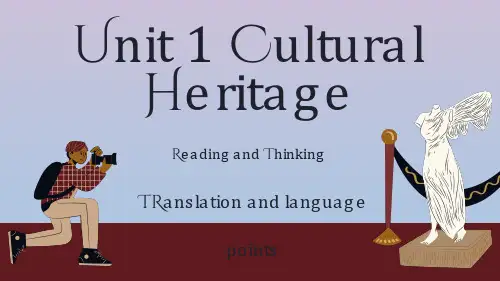
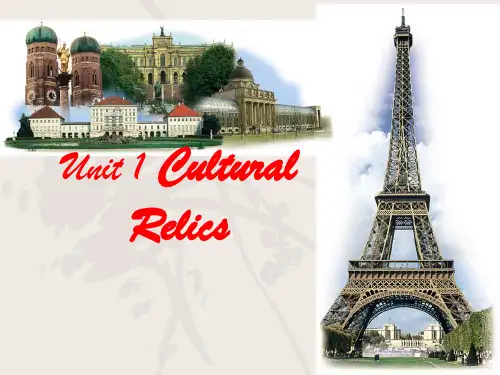
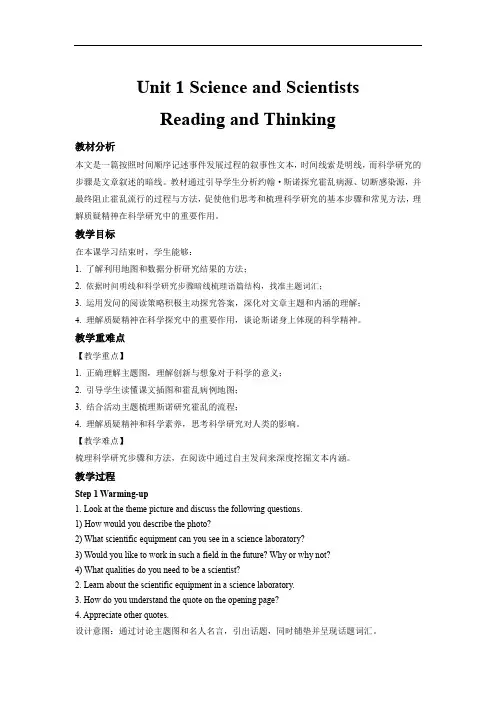
Unit 1 Science and ScientistsReading and Thinking教材分析本文是一篇按照时间顺序记述事件发展过程的叙事性文本,时间线索是明线,而科学研究的步骤是文章叙述的暗线。
教材通过引导学生分析约翰·斯诺探究霍乱病源、切断感染源,并最终阻止霍乱流行的过程与方法,促使他们思考和梳理科学研究的基本步骤和常见方法,理解质疑精神在科学研究中的重要作用。
教学目标在本课学习结束时,学生能够:1. 了解利用地图和数据分析研究结果的方法;2. 依据时间明线和科学研究步骤暗线梳理语篇结构,找准主题词汇;3.运用发问的阅读策略积极主动探究答案,深化对文章主题和内涵的理解;4. 理解质疑精神在科学探究中的重要作用,谈论斯诺身上体现的科学精神。
教学重难点【教学重点】1. 正确理解主题图,理解创新与想象对于科学的意义;2. 引导学生读懂课文插图和霍乱病例地图;3. 结合活动主题梳理斯诺研究霍乱的流程;4. 理解质疑精神和科学素养,思考科学研究对人类的影响。
【教学难点】梳理科学研究步骤和方法,在阅读中通过自主发问来深度挖掘文本内涵。
教学过程Step 1 Warming-up1. Look at the theme picture and discuss the following questions.1) How would you describe the photo?2) What scientific equipment can you see in a science laboratory?3) Would you like to work in such a field in the future? Why or why not?4) What qualities do you need to be a scientist?2. Learn about the scientific equipment in a science laboratory.3. How do you understand the quote on the opening page?4. Appreciate other quotes.设计意图:通过讨论主题图和名人名言,引出话题,同时铺垫并呈现话题词汇。
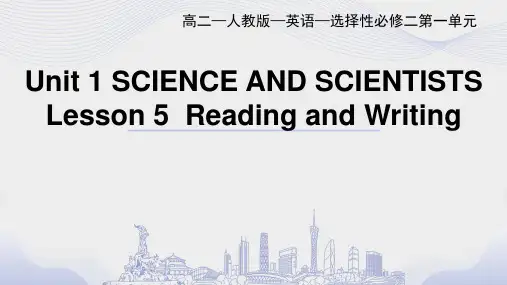
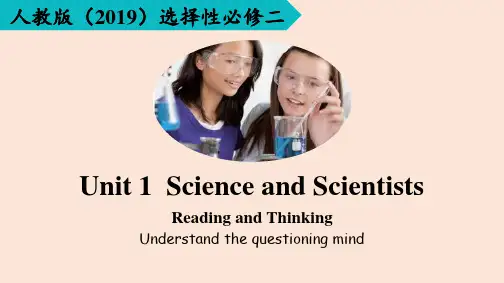
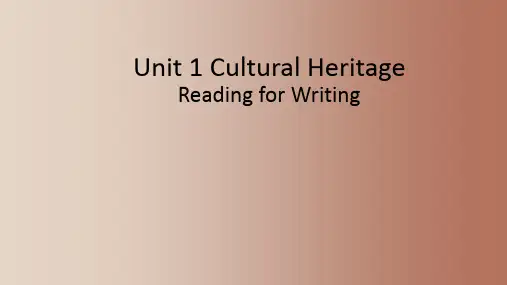
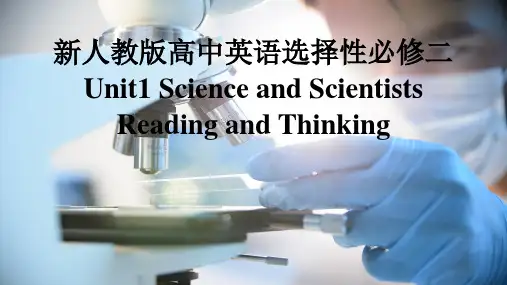
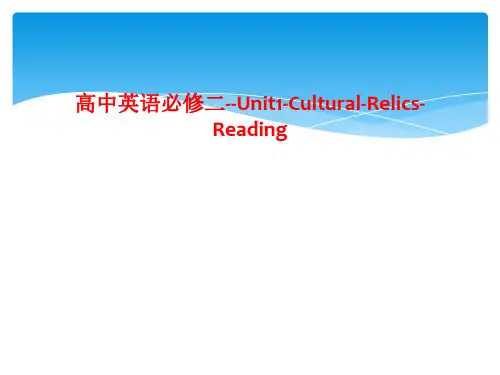
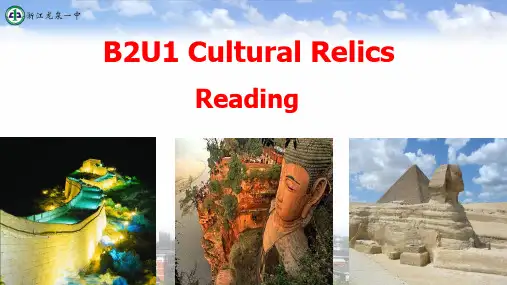
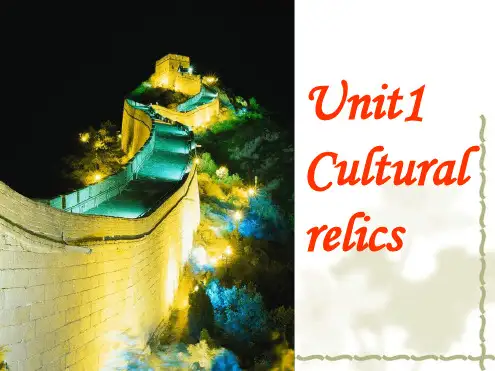
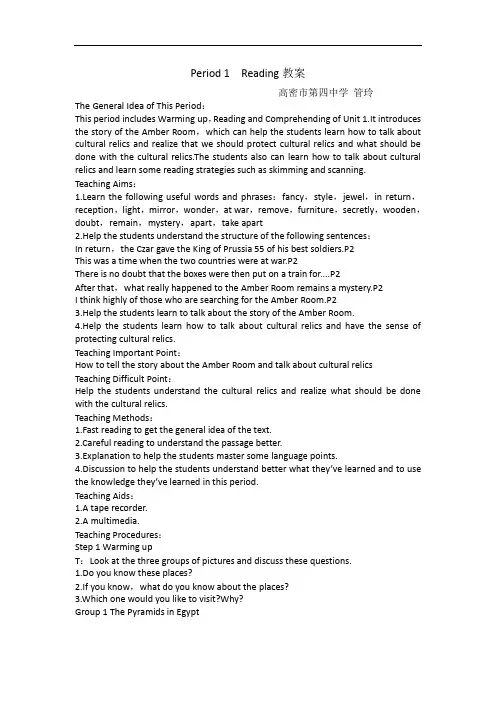
Period 1 Reading教案高密市第四中学管玲The General Idea of This Period:This period includes Warming up,Reading and Comprehending of Unit 1.It introduces the story of the Amber Room,which can help the students learn how to talk about cultural relics and realize that we should protect cultural relics and what should be done with the cultural relics.The students also can learn how to talk about cultural relics and learn some reading strategies such as skimming and scanning.Teaching Aims:1.Learn the following useful words and phrases:fancy,style,jewel,in return,reception,light,mirror,wonder,at war,remove,furniture,secretly,wooden,doubt,remain,mystery,apart,take apart2.Help the students understand the structure of the following sentences:In return,the Czar gave the King of Prussia 55 of his best soldiers.P2This was a time when the two countries were at war.P2There is no doubt that the boxes were then put on a train for....P2After that,what really happened to the Amber Room remains a mystery.P2I think highly of those who are searching for the Amber Room.P23.Help the students learn to talk about the story of the Amber Room.4.Help the students learn how to talk about cultural relics and have the sense of protecting cultural relics.Teaching Important Point:How to tell the story about the Amber Room and talk about cultural relics Teaching Difficult Point:Help the students understand the cultural relics and realize what should be done with the cultural relics.Teaching Methods:1.Fast reading to get the general idea of the text.2.Careful reading to understand the passage better.3.Explanation to help the students master some language points.4.Discussion to help the students understand better what they’ve learned and to use the knowledge they’ve learned in this period.Teaching Aids:1.A tape recorder.2.A multimedia.Teaching Procedures:Step 1 Warming upT:Look at the three groups of pictures and discuss these questions.1.Do you know these places?2.If you know,what do you know about the places?3.Which one would you like to visit?Why?Group 1 The Pyramids in EgyptGroup 2 The Great Wall/ChinaT:Please tell the reasons for their importance.S1:Symbols of their countries.S2:A concrete annotation of their cultures.S3:Have a memorable significance.S4:Bring in money from tourism.The warming-up exercise helps the students realize that there are some well-known cultural relics both at home and abroad.Ask the students to try their best to think of the cultural relics that they know.T:Now,class,look at the title of this unit.Tell me what the topic of this unit is. Ss:The topic of this unit is cultural relics.T:Do you know what cultural relics are?Ss:Cultural relics are something that has survived for a long time,often a part of something old that has remained when the rest of it has been destroyed;it tells people about the past.T:Very good,also we can say:Cultural relics are traces or features surviving from a past age and serving to remind people of them.Just like what you said,they represent the culture of a place and some periods of history.Of course,some of them are in danger because they are being destroyed.Then can you give some examples of the cultural relics that are in the need of being protected?S1:The Great Wall.S2:The Big Ben.Ss:...T:Yes.You are right.Now do you want to know more about these cultural relics? Ss:Yes.Step 2 Pre-readingT:What is your favorite city?Why?What makes a city great?S1:a long historyS2:cultural relicsS3:many great peopleS4:important events taking place thereT:All of you have done a good job.Now let’s come to the text “In Search Of the Amber Room”.Listen to the tape and finish the comprehending exercises.The suggested answers to the comprehending exercise 1:1. D2. C3.A4. A5. D6. C2.The suggested answers to the comprehending exercise 2:TFTF3.The suggested answers to the comprehending Exercise 3:1. 普鲁士国王威廉一世绝不可能想到他送给俄罗斯人民的厚礼会由这样一般令人惊讶的历史。
Lanzhou,9 August 2017. A group of researchers and scientists from China and other countries areworking together to help increase knowledge and appreciation of China’s ancient cultural heritage.They are recording and collecting digital images of cultural relics from the Mogao Caves,which were akey stop along the Silk Road throughout China’s ancient history. Nearly 500,000 high-quality digitalphotographs have been produced since the international project started in 1994.2017年8月9日,兰州。
一组来自中国和其他国家的研究人员和科学家正在共同努力,以增加对中国古代文化遗产的了解和欣赏。
他们正在记录和收集来自莫高窟文物的数字图像,莫高窟是中国古代历史上丝绸之路的一个重要站点。
自1994年国际项目开始以来,已经制作了近50万张高质量的数码照片。
The Mogao Caves have long been a meeting point for different cultures and are part of the historyof many countries. Today, the caves are just as international as they were at the time when peopletravelled the Silk Road. Tourists from all over the world visit Dunhuang to see the caves, and the GettyMuseum in LosAngeles has even reproduced a copy of the caves and paintings for people to admire inAmerica.莫高窟长期以来一直是不同文化的交汇点,也是许多国家历史的一部分。